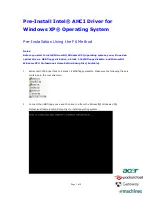
1.
An MPLS echo request packet containing a single VPN IPv4 sub-TLV is sent from
PE 1 with the following attributes:
10.1.1.1
Source address
127.0.0.0/8
Destination address
3503
UDP port
255
TTL
Randomly generated 32-bit number used to match the reply
Sender’s handle
Integer that is incremented for each echo request packet
Sequence number
The VPN IPv4 sub-TLV has the route distinguisher set to that of the VRF and the
IPv4 prefix set to 10.99.99.21/32. The packet exits PE 1 with two labels.
2.
Router P 1 switches labels based on the outer label of the packet and forwards
the packet to P 2.
3.
Router P 2 switches labels based on the outer label of the packet and forwards
the packet to PE 2.
4.
Router PE 2 pops both labels and determines that the destination address is in
the 127.0.0.0/8 subnet. PE 2 sends the packet up to the control plane. The MPLS
ping application on the control plane then creates an MPLS echo reply to the
received echo request. The echo reply packet has a return code of 3, which
means that the replying router is an egress for the FEC at stack depth. The echo
reply packet includes the Interface and Label Stack TLV to indicate both the
interface on which the request packet was received and the incoming label stack.
The MPLS echo reply packet is sent back as a (labeled) UDP packet with the
following attributes:
10.2.2.2
Source address
10.1.1.1
Destination address
3503
UDP port
5.
When the MPLS echo reply reaches router PE 1, the router matches the sender’s
handle and the sequence number to the echo request packet that PE 1 sent. The
CLI displays an exclamation point (!).
Packet flow for an MPLS trace to an L3VPN IPv4 prefix is the same as for an IPv4
prefix except that the echo request packets and echo reply packets contain the VPN
IPv4 sub-TLV instead of the LDP IPv4 sub-TLV. The following sample output represents
what you might see when you issue the
trace mpls l3vpn
and
trace mpls l3vpn vrf
commands for the topology shown in Figure 67 on page 366.
370
■
Packet Flow Examples for Verifying MPLS Connectivity
JUNOSe 11.0.x BGP and MPLS Configuration Guide
Содержание JUNOSE
Страница 6: ...vi...
Страница 8: ...viii JUNOSe 11 0 x BGP and MPLS Configuration Guide...
Страница 24: ...xxiv Table of Contents JUNOSe 11 0 x BGP and MPLS Configuration Guide...
Страница 37: ...Part 1 Border Gateway Protocol Configuring BGP Routing on page 3 Border Gateway Protocol 1...
Страница 38: ...2 Border Gateway Protocol JUNOSe 11 0 x BGP and MPLS Configuration Guide...
Страница 234: ...198 Monitoring BGP JUNOSe 11 0 x BGP and MPLS Configuration Guide...
Страница 236: ...200 Multiprotocol Layer Switching JUNOSe 11 0 x BGP and MPLS Configuration Guide...
Страница 298: ...262 Point to Multipoint LSPs Configuration JUNOSe 11 0 x BGP and MPLS Configuration Guide...
Страница 346: ...310 Example Traffic Class Configuration for Differentiated Services JUNOSe 11 0 x BGP and MPLS Configuration Guide...
Страница 535: ...There is no no version See undebug ip mbgp Monitoring BGP MPLS VPNs 499 Chapter 5 Configuring BGP MPLS Applications...
Страница 536: ...500 Monitoring BGP MPLS VPNs JUNOSe 11 0 x BGP and MPLS Configuration Guide...
Страница 538: ...502 Layer 2 Services Over MPLS JUNOSe 11 0 x BGP and MPLS Configuration Guide...
Страница 592: ...556 Multiple ATM Virtual Circuits over a Single Pseudowire Example JUNOSe 11 0 x BGP and MPLS Configuration Guide...
Страница 604: ...568 Virtual Private LAN Service JUNOSe 11 0 x BGP and MPLS Configuration Guide...
Страница 618: ...582 VPLS References JUNOSe 11 0 x BGP and MPLS Configuration Guide...
Страница 642: ...606 VPLS Configuration Example with LDP Signaling JUNOSe 11 0 x BGP and MPLS Configuration Guide...
Страница 674: ...638 Virtual Private Wire Service JUNOSe 11 0 x BGP and MPLS Configuration Guide...
Страница 718: ...682 Monitoring MPLS Forwarding Table for VPWS JUNOSe 11 0 x BGP and MPLS Configuration Guide...
Страница 719: ...Part 6 Index Index on page 685 Index 683...
Страница 720: ...684 Index JUNOSe 11 0 x BGP and MPLS Configuration Guide...
















































